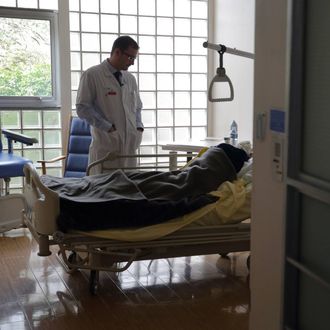
How good are American nursing homes at palliative care? Given that these are the settings in which many people spend the last days of their lives, it’s an important question. A bunch of prior research has shown that in the absence of solid end-of-life planning, many people who are close to death endure painful, intrusive medical procedures that add little to their lives’ quality or quantity and that may in some cases actually detract from both.
In a new study in the Journal of Palliative Medicine, a team led by Susan Miller of the Brown University School of Public Health attempted to better understand how U.S. nursing homes are doing at end-of-life care by sending out a survey to the directors of nursing, or DONs, at a random sample of 1,981 of them. The idea was to see how well these DONs responded to questions about both their personal knowledge of palliative-care practices and about how their facilities handled these issues, and to then draw correlations between these scores and the end-of-life outcomes of 58,876 residents of these facilities — whether they ended up dying in a hospital, whether they endured potentially uncomfortable last-minute medical-interventions, and so on.
The knowledge questions “reflected relatively elementary knowledge,” the authors write, and were scored only on a scale of 0 to 3 (there was a larger scale for the practice questions). Somewhat alarmingly, 21 percent of the DONs surveyed “correctly responded to none or only one of the knowledge items, and 43 percent to all items.” More than half of the DONs, in other words, didn’t appear to know the basics of how palliative care works.
This matters, potentially a lot, because the researchers found that all else being equal, a one-point increase in a DON’s knowledge score corresponded with a 12 percent reduction in the likelihood that a patient near the end of life in that facility would endure tube feeding; a 7 percent reduction in the likelihood that they would be hospitalized in the last 30 days of their life; a 9 percent likelihood that they would die in the hospital; and a 13 percent increase in the likelihood that they would be given a documented prognosis of having six months left to live (which makes planning easier for both the patient and the family, and likely reduces the probability of aggressive and/or unnecessary medical interventions).
The researchers found far fewer statistically significant correlations with the practice survey, and the fact that the knowledge one had a maximum of only three points imposes some limitations on what can be drawn from this survey (to see why, imagine an IQ test that attempted to capture the full range of human intelligence on just three rather basic questions). Plus, as the researchers themselves point out, they “cannot discount the possibility that it may not be the level of PC knowledge and practice per se that results in these outcomes but that there are greater levels of PC knowledge and practice in NHs that provide higher quality of care in general” — that things go the other way around, in other words. Future research (as always) is needed to better understand what’s what.
Either way, though, it’s clear that comprehensive palliative care goes hand-in-hand with good care in general. It’s also clearly a bad sign that the DONs at so many nursing homes couldn’t correctly answer basic questions about palliative care. We can probably do a lot better than that.




